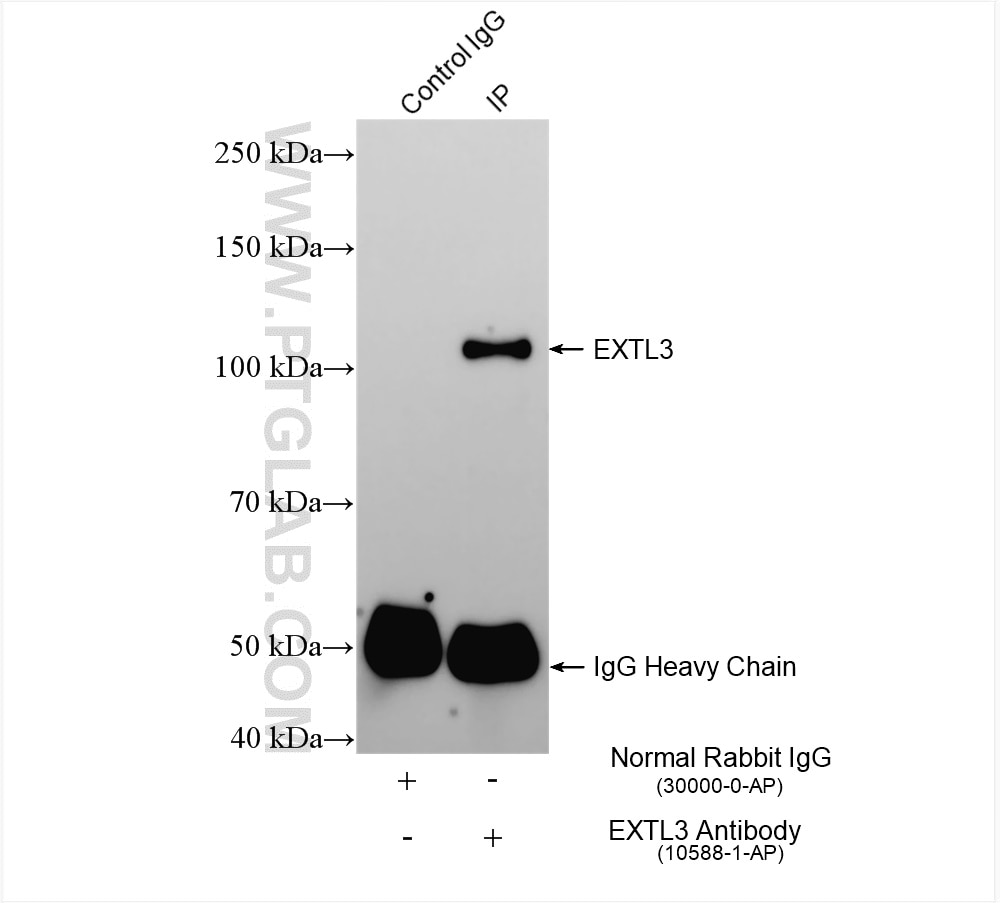Tested Applications
| Positive IP detected in | HEK-293T cells, mouse pancreas tissue |
Recommended dilution
| Application | Dilution |
|---|---|
| Immunoprecipitation (IP) | IP : 0.5-4.0 ug for 1.0-3.0 mg of total protein lysate |
| It is recommended that this reagent should be titrated in each testing system to obtain optimal results. | |
| Sample-dependent, Check data in validation data gallery. | |
Published Applications
| WB | See 2 publications below |
| IF | See 2 publications below |
Product Information
10588-1-AP targets EXTL3 in WB, IF, IP, ELISA applications and shows reactivity with human, mouse samples.
| Tested Reactivity | human, mouse |
| Cited Reactivity | human, mouse |
| Host / Isotype | Rabbit / IgG |
| Class | Polyclonal |
| Type | Antibody |
| Immunogen |
CatNo: Ag0936 Product name: Recombinant human EXTL3 protein Source: e coli.-derived, PGEX-4T Tag: GST Domain: 620-919 aa of BC006363 Sequence: DPVLPSEAKFLGSGTGFRPIGGGAGGSGKEFQAALGGNVPREQFTVVMLTYEREEVLMNSLERLNGLPYLNKVVVVWNSPKLPSEDLLWPDIGVPIMVVRTEKNSLNNRFLPWNEIETEAILSIDDDAHLRHDEIMFGFRVWREARDRIVGFPGRYHAWDIPHQSWLYNSNYSCELSMVLTGAAFFHKYYAYLYSYVMPQAIRDMVDEYINCEDIAMNFLVSHITRKPPIKVTSRWTFRCPGCPQALSHDDSHFHERHKCINFFVKVYGYMPLLYTQFRVDSVLFKTRLPHDKTKCFKFI Predict reactive species |
| Full Name | exostoses (multiple)-like 3 |
| Calculated Molecular Weight | 105 kDa |
| Observed Molecular Weight | 105 kDa |
| GenBank Accession Number | BC006363 |
| Gene Symbol | EXTL3 |
| Gene ID (NCBI) | 2137 |
| RRID | AB_2262577 |
| Conjugate | Unconjugated |
| Form | Liquid |
| Purification Method | Antigen affinity purification |
| UNIPROT ID | O43909 |
| Storage Buffer | PBS with 0.02% sodium azide and 50% glycerol, pH 7.3. |
| Storage Conditions | Store at -20°C. Stable for one year after shipment. Aliquoting is unnecessary for -20oC storage. 20ul sizes contain 0.1% BSA. |
Background Information
Exostosin like glycosyltransferase 3 (EXTL3), also known as RPR, is located at chromosome 8p21.1 and composed of 919 amino acids, making it the longest member of the EXT family (PMID: 35676258). EXTL3 encodes the glycosyltransferases responsible for the biosynthesis of the backbone structure of heparan sulfate (HS) (PMID: 24128412). EXTL3 has been identified as a receptor molecule for regenerating islet-derived (REG) protein ligands, which have been shown to stimulate islet β-cell growth. Mutations in EXTL3 could lead to skeletal dysplasia, developmental delay, and severe immune deficiency (PMID: 28148688). The predicted molecular weight is 105 kDa, but we detected the band at 65 kDa perhaps due to alternative splicing (PMID: 14618397).
Protocols
| Product Specific Protocols | |
|---|---|
| IP protocol for EXTL3 antibody 10588-1-AP | Download protocol |
| Standard Protocols | |
|---|---|
| Click here to view our Standard Protocols |
Publications
| Species | Application | Title |
|---|---|---|






